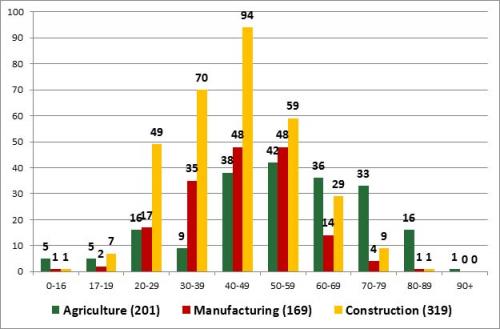Agriculture’s aging workforce presents personal safety concerns
The average age of farm owner/operators continues to increase each year. Research shows that the single largest age category for work-related fatalities on farms is the 60+ age group.
Working in agriculture is a great way of life and it’s very rewarding to those who choose this noble occupation. Agriculture is also an occupation that presents more danger than an average job. Michigan Fatality Assessment and Control Evaluation (MIFACE) research from 2001-2011 shows that agriculture has a higher rate of work related deaths per 100,000 workers than construction, manufacturing, transportation or the average of all Michigan industries.
Deb Chester, MIFACE Project Coordinator shared some of these statistics at the recent Michigan Safety Conference during the agriculture section breakout. This year’s agriculture section was the second time that the conference has featured agriculture safety, and was the result of a diverse planning committee including industry representatives, Michigan State University Extension, MSU’s Department of Medicine and Michigan Farm Bureau. One of the surprises that Deb shared in her presentation was that 86 of the 201 fatalities in agriculture from 2001-2011 were individuals older than 60 years of age.

Age at work related fatal incident: 2001-2011
Deb shared some possible reasons for this higher fatality rate in older farmers. First, farmers work long hard hours to accomplish the tasks on the farm. As we get older, those long hours can really take a toll. As farmers age, they need to recognize their increased limitations. Staying alert, well rested and listening to our bodies could mean the difference in coming home to your family at night or not.
A second possible reason is complacency. Let’s face it, this is the most experienced group of workers on the farm. They know how to get the job done, they know how to operate the machinery, etc. Sometimes we weren’t taught to or haven’t always done things in the safest manner, but we have never had an accident. Maybe we’ve had a few close calls, but then who hasn’t, right?
Evidence of this complacency is the piece of equipment responsible for the majority of work related agricultural fatalities. Tractors accounted for nearly 70 percent of the fatalities – of these, tractor overturns and run overs accounted for 57 percent of the fatalities. Tractors involved in the fatal overturns were not equipped with a rollover protection structure (ROPS) and seat belt, or if equipped, the operator was not wearing the seat belt. Additionally, most of the tractor overturns occurred on flat ground, not on a hill. Most runovers occurred when the operator was starting the tractor from the ground and didn’t know the tractor was in gear.
Because we are so familiar with how to operate a tractor and we know the task so well, we sometimes let our mind wander and our attention is not on the task at hand which can lead to injury or death. We can also think it’s acceptable to skip important safety steps because we’ve never had an accident before. One non-farm example of familiarity and mind wandering would be driving your car. Have you ever arrived somewhere and felt like you couldn’t remember part of the trip as well as you should be able to?
To reduce complacency, actively look for hazardous risk, work to minimize these risks and work toward habits that include safety as a primary goal.
In future articles, we’ll cover some of the important concepts shared at this year’s Michigan Safety conference and discuss how farmers and their employees can increase personal safety both on and off the farm.



 Print
Print Email
Email




